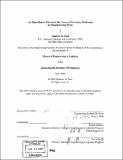| dc.contributor.advisor | James Masters. | en_US |
| dc.contributor.author | Burt, Matthew H. (Matthew Howard), 1969- | en_US |
| dc.contributor.other | Massachusetts Institute of Technology. Engineering Systems Division. | en_US |
| dc.date.accessioned | 2005-08-23T14:46:58Z | |
| dc.date.available | 2005-08-23T14:46:58Z | |
| dc.date.copyright | 2000 | en_US |
| dc.date.issued | 2000 | en_US |
| dc.identifier.uri | http://hdl.handle.net/1721.1/8726 | |
| dc.description | Thesis (M.Eng.)--Massachusetts Institute of Technology, Engineering Systems Division, 2000. | en_US |
| dc.description | Includes bibliographical references (leaf 52). | en_US |
| dc.description.abstract | The recent trends in manufacturing toward lower inventory levels, shorter cycle times, and more closely integrated production schedules have led to an extremely low tolerance for inventory stock-outs. In such an environment, any shortage is costly, and understanding why stock-outs occur and how to prevent them is an important issue. However, the answer to the question of why stock-outs occur is not always easy to determine. Investigations into the root causes of inventory stock-outs are often hindered by data collection problems, data overload, and the investigators' lack of a well-accepted, systematic framework with which to conduct the analysis, resulting in a cursory review of the problem and a subjective diagnosis. This thesis proposes an algorithm to determine objectively the causes of inventory stockouts in manufacturing firms. Instead of observing stock-outs through the lens of the classical inventory model that aggregates all variations in resupply time and demand during leadtime into one variable, this thesis attempts to view the problem with a broader supply chain perspective that considers multiple sources of variation. Given data that describe the transactions of materials and information between members of the supply chain, the algorithm identifies which causes among a prescribed set of causes lead to a given stock-out occurrence. The transaction data is analyzed using a simple supply chain model to determine how each possible stock-out cause could affect actual inventory performance compared to planned inventory performance. This approach to analyzing inventory stock-outs has many possible uses, including its use as a supply chain metric to evaluate efforts to minimize inventory stock-outs. | en_US |
| dc.description.statementofresponsibility | by Matthew H. Burt. | en_US |
| dc.format.extent | 52 leaves | en_US |
| dc.format.extent | 4185406 bytes | |
| dc.format.extent | 4185168 bytes | |
| dc.format.mimetype | application/pdf | |
| dc.format.mimetype | application/pdf | |
| dc.language.iso | eng | en_US |
| dc.publisher | Massachusetts Institute of Technology | en_US |
| dc.rights | M.I.T. theses are protected by copyright. They may be viewed from this source for any purpose, but reproduction or distribution in any format is prohibited without written permission. See provided URL for inquiries about permission. | en_US |
| dc.rights.uri | http://dspace.mit.edu/handle/1721.1/7582 | |
| dc.subject | Engineering Systems Division. | en_US |
| dc.title | An algorithm to determine the causes of inventory stock-outs in manufacturing firms | en_US |
| dc.type | Thesis | en_US |
| dc.description.degree | M.Eng. | en_US |
| dc.contributor.department | Massachusetts Institute of Technology. Engineering Systems Division | |
| dc.identifier.oclc | 48035233 | en_US |
